Should I use a foam roller in my warm up?
Foam rolling is very popular in some parts of training, one of the questions we are asked is “How Can I use a foam roller in my warm up?” Here is an in depth look at that, with references and some exercises shown.
What is Foam rolling?
The myofascial system is made up of muscle and fascia, a tough sheet of connective tissue that envelopes muscle fibres. Through injury, overtraining, poor posture, poor movement mechanics and insufficient recovery, painful “trigger points” can build up in the myofascial system.
These trigger points are often described as adhesions and occur in areas of tight muscle where muscle fibres and fascia effectively become stuck together. This can restrict movement about a joint, and also places strain on surrounding tissues which must compensate for the weakness and can lead to injury.
Myofascial release is a massage technique used to break down the adhesions and increase extensibility of the muscle. There are two types of myofascial release which are used by practitioners:
1) Direct Pressure- direct pressure to adhesion, breaks down adhesions and scar tissue
2) Sweeping pressure- long strokes along full length of muscle, reduces muscle tension and promotes soft tissue extensibility.
Foam rolling is a technique for self administering myofascial release. The technique involves applying pressure to the target area using the foam roller, and manipulating the position by rolling backwards and forwards along the length of the muscle.
Using the foam roller is a cost effective way of achieving full body massage, leading to improved performance and reduced risk of injury.
Some common exercises
The foam roller can be used to treat any tight muscle group, and below are some of the most common exercises for major muscles of the lower body.
Hamstrings–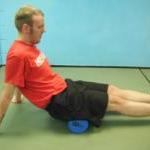
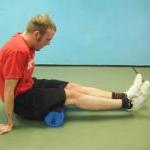
Glutes- 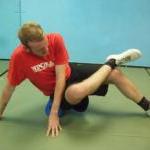
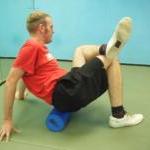
Thighs-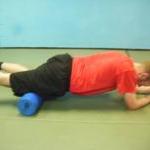
Should a foam roller be used during warm ups?
There is a growing body of evidence detailing the benefits of foam rolling/myofascial release but when is the most effective time to implement it?
Pre-Training:
There is a wealth of anecdotal support for the use of foam rolling before training. Experienced practitioners such as Dr David Ginsberg (2010 team chiropractor for Chicago Slaughter Professional Indoor Football team, current injury consultant for St. Charles Gymnastics Academy) advocates the use of foam rolling, using superficial sweeping pressure techniques, in warm ups to relax and loosen tight muscle groups.
The use of this technique has also been supported by a recent study by D’Amico & Morin (2011). Following a foam roller warm up protocol of 15 strokes back and forth along the hamstrings, subjects improved static strength and jump performance whilst also maintaining range of motion compared to a control group performing static stretching.
However, the mechanism by which static strength and power were improved in this study was suggested to be an increase in muscle temperature. Therefore any warm up strategy including dynamic stretching and low load movement could result in a similar improvement in performance.
Although the volume of research conducted into pre-exercise myofascial release and massage is limited, the majority of studies have found no benefit to performance compared to control trials.
Studies by Harmer (1991) and Goodwin et al., (2007) found that pre-performance massage had no significant effect on subsequent sprint performances. Furthermore, Fletcher (2010) found that fast, superficial myofascial release techniques used during a warm up resulted in slower sprint performances than an active warm up.
It should also be noted that myofascial release practitioners warn against using the direct pressure technique immediately before training or competition. Direct Pressure will break up scar tissue and result in an inflammatory response. Exercising immediately after this could result in further inflammation and possibly injury.
Post Training:
There has been extensive research on the effects of foam rolling when used post training. A review by Bret Contreras and Chris Beardsley (S+C Research December, 2014) describes two recent studies looking at effects on recovery from training, and on mobility.
A study by Kim et al., (2014) investigated the effect of foam rolling on recovery from physical stress. Participants performed 30 minutes of exercise followed immediately by foam rolling or passive rest, with levels of the stress hormone cortisol then measured and compared.
The researchers found that there was no significant difference in reduction of cortisol between the two groups. This suggests that foam rolling immediately post training/competition has little impact on recovery.
However, a study by Mohr et al., (2014) showed more positive effects of foam rolling. Participants completed one of three different mobility programmes over the course of a week (foam rolling, stretching, foam rolling and stretching; there was also a control group with no programme).
All three groups increased passive hip flexion ROM, with static stretching (12°) being twice as effective as foam rolling (6°). However when combined together, the effects of stretching and foam rolling (23.5°) were almost twice as effective compared to stretching alone.
Conclusions
Foam rolling has been shown to significantly increase mobility when performed in conjunction with traditional stretching routines. Using the foam roller every day before stretching exercises looks to enhance mobility which could impact on both performance and injury prevention.
This could be done either after training, or at a later part of the day away from training, as research suggests no benefit of rolling immediately post-training.
Despite popularity and anecdotal support for using foam rollers before training and competition, there is no evidence to suggest they provide any benefit to performance or injury prevention compared to more active warm up techniques.
Once more, there is a potential danger of injury if used excessively prior to training or competition. Dynamic active warm ups should still be the major focus when preparing an athlete for training or competition.
Matt Durber
References
Beardsley, C. and Contreras, B. (2014) Strength and Conditioning Research, December (Foam roller edition).
D’Amico, A. and Morin, C. (2011) Effects of Myofascial Release on Human Performance. In association with Bridgewater State University. Retrieved from http://www.fiteval.com/Site_1/Research_Study.html
Goodwin, J.E., Glaister, M., Howatson, G., Lockey, R.A., and McInnes, G. (2007) Effect of Pre-performance Lower-Limb Massage on Thirty-Meter Sprint Running. Journal of Strength and Conditioning Research, 21 (4), 1028-1031.
Fletcher, IM. (2010) The effects of precompetition massage on the kinematic parameters of 20-m sprint performance. Journal of Strength and Conditioning Research, 24(5), 1179-83.
Harmer, P. (1991) The effect of pre-performance massage on stride frequency in sprinters. Journal of Athletic Training, 26, 55-8.
Kim, K., Park, S., Goo, B.O., and Choi, S.C. (2014) Effect of self-myofascial release on reduction of physical stress: a pilot study Journal of Physical Therapy Science, 26 (11), 1779-1781.
Mohr, A.R., Long, B.C., and Goad, C.L. (2014) Effect of foam rolling and static stretching on passive hip-flexion range of motion Journal of Sport Rehabilitation (forthcoming).

Foam rolling or a variety of SMR techniques are used by me with the Sheffield Eagles players as part of a players individual preparation – is this warm-up, pre-warm -up, session prep? I think these are some the ‘new terms’ that have been created. Bottom line is that the players engage in a progressive and individually owned warm-up, that starts with a ‘go to’ activity which may be sun / moon yoga routine; bar warm -up; track style warm-up; OH squat variations (my personal go to). Understand this is only for 3 mins max to ‘identify’ for this day, at this time, for this session do I have any major constraints to movement. SMR and static stretch (yes, static stretch – no-one seems to have mentioned the role with autogenic inhibition)), moving into more active -dynamic, and metabolically more demanding and specific to session. However, as an individual player, we aim to ascertain whether they need to start at the level of SMR / static or maybe they do respond better to more active / dynamic methods. Also if the area persists to be a source of major issue, then we need to look at causes more closely (often we do find that the approach described puts the athlete into improved movement patterns so the actual session / exercises completed lead to an gradual improvement rather than requiring any outside interventions that can remove them from my training environment).
The danger is though that players get comfortable coming in and going straight to the rollers! So we make them write out every three weeks what are there priority areas (and we don’t accept back, thigh, calves,and hamstrings all as priorities) how have they determined this (their go to); and which activities they are selecting to work on this, and then how do they ramp up with warm-up. Players are not allowed to go straight to physio and rubs are banned unless players have followed this process.
Thanks Matt. I thought it was a bit too good to be true to be effective in warm ups. I got one for my birthday and use it at the end of the day before static stretching.
If part of the warm up is for mental prep/ skill acquisition, then I can’t see how a foam roller helps.
If I was warming up to fight Mike Tyson, the last thing I would do would be to lie down on a foam roller. (I might be practicing running in circles very fast)
Yes I agree I would never use it as a warm up by itself, although sometimes it can be useful as a pre-warm up activity. For example, often tight lats make front squats and cleans more difficult, so some pre warm up foam rolling to the area can increase range of movement and allow better technique.
On the whole though with time constraints, I find it is generally best to use the foam roller in a separate mobility session later in the day.
Interesting article, working at a Nuffield Health fitness centre we’re encouraged to use them at the end of a warm up during PT sessions (although this is of course for sessions aimed at improving general fitness as opposed to being sports specific). Haven’t really had much chance to read a collection of evidence on the benefiots of ‘pre-rolling’ as it were, and yes I wouldn’t use it for sport or S&C sessions. General PT on the other hand….
Alex (from June’s L2 S&C course)
Hi,
thanks for this comment (anonymous again). This looks like a reasonable approach with sound processes and thought underpinning it.
This is clearly better than “everyone else does it” or “I went on a course and all I came back with was this lousy foam roller”.
It is amazing how many players only need “physio rubs” when a physio appears!.
[…] Massage- self or other if you are lucky. […]